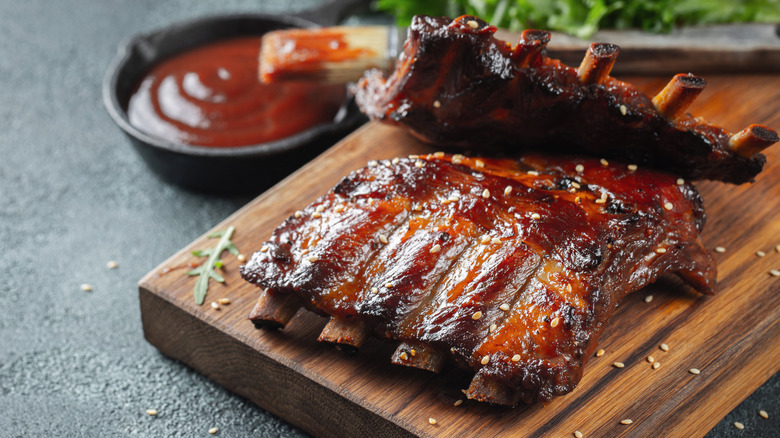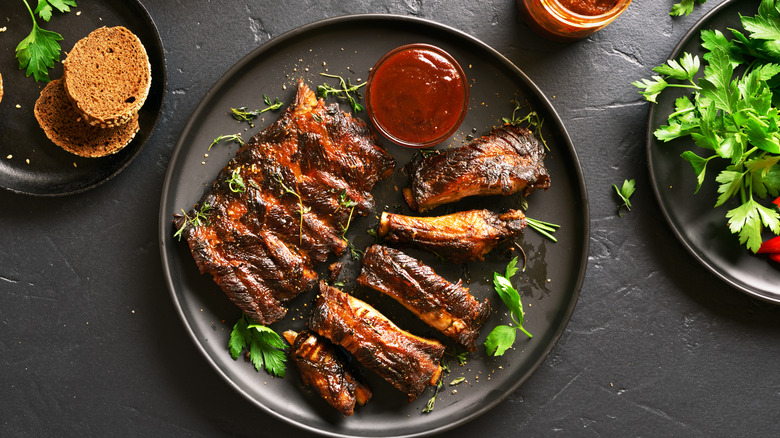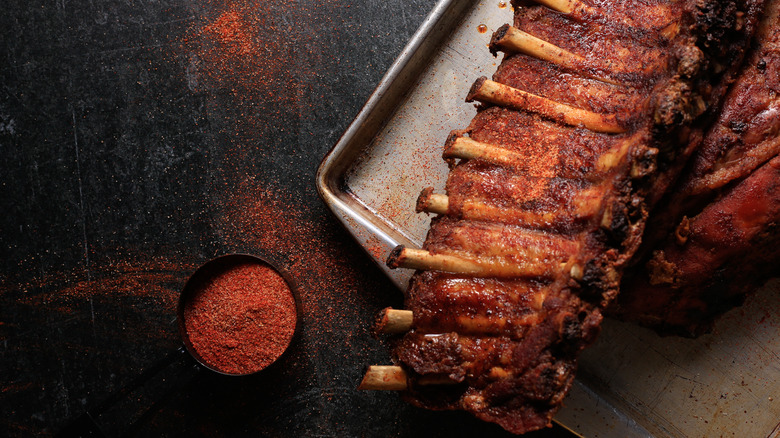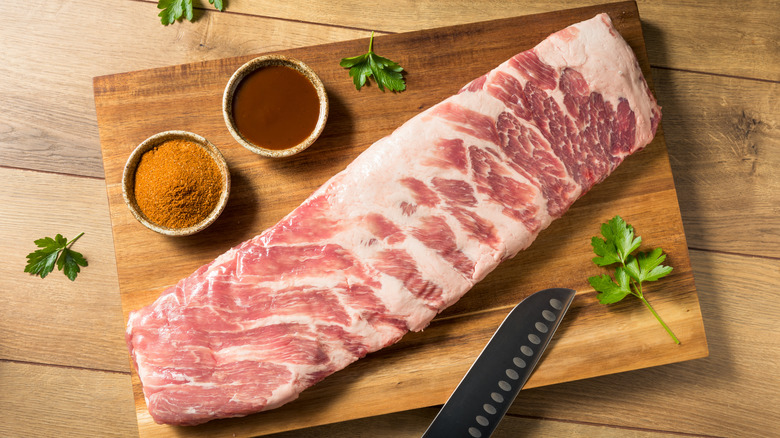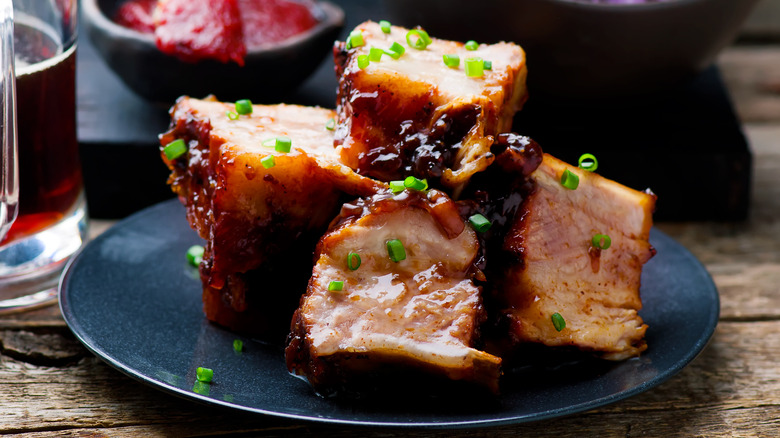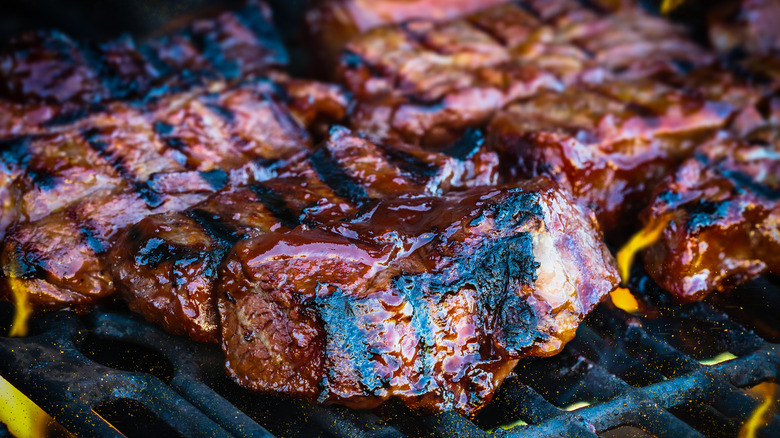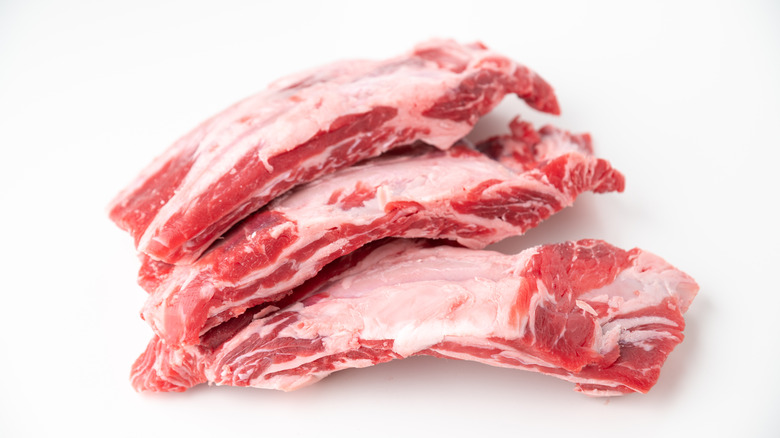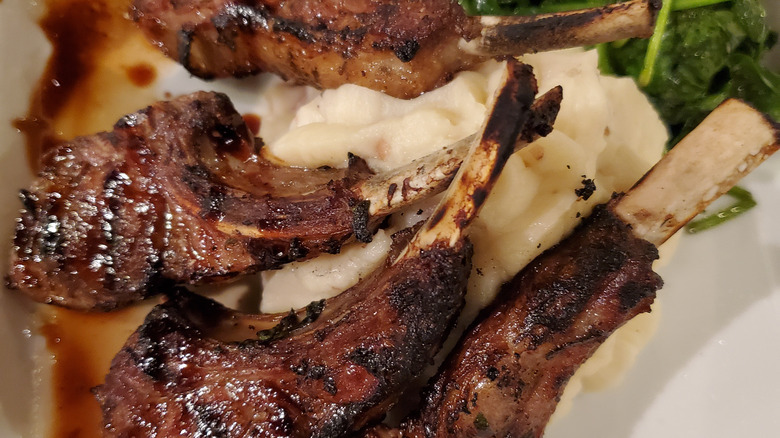10 Types Of Ribs Explained
There's a lot more to ribs than you might expect — and a wider variety than you may realize. In addition to classic, well-known fixtures at barbecue restaurants across the country, there's a whole world of options, all waiting to be explored, cooked, smoked, sauced, and in some cases, scooped up with seashells. Each type has its own merits and moments, lending its own distinct flavor and texture. Whether they're sourced from pork, beef, lamb, or fish, ribs hold up differently under particular cooking methods and with certain seasonings — and even secret-ingredient sauces.
That's why it helps to distinguish one type of rib from another, depending on whether you're preparing a casual backyard cookout or craving some Korean kalbi. Deriving from the land or the sea, rib meat is a surprisingly bountiful and versatile realm of cookery. All it takes is a reputable butcher (or fishmonger), ample cooking space, plus, in most cases, a patience for low and slow cooking, and your taste buds will be rewarded.
Pork spare ribs
Some of the most common and widely available ribs on the market, pork spare ribs are similar to baby back ribs, albeit a tad richer. They come from the ends of baby backs, along the breast bone, and extend around the belly and attach to the sternum (via Texas Monthly). These ribs contain a desirable amount of well-marbled meat between the bones, giving it that fatty, tender texture which make these a go=to for BBQ from Texas to China.
Typically, a full slab consists of 11 or more ribs. The membrane must be removed, excess fat trimmed, and the pork should be seasoned ahead of time to your liking, before cooking low and slow for hours — this allows all that fat to melt enough and tenderize the meat. While they can be cooked over a grill or in a smoker, spare ribs can also be prepared in an oven.
Baby back ribs
When most people think of ribs, chance are good that baby backs are what come to mind. The subject of the iconic Chili's baby back ribs jingle, these come from where the rib meets the spine after the loin is removed. The upper portion of the ribs, they get their name from the fact that they're shorter and smaller compared to the adjoining spare ribs (via BBQ Host), so rest assured: These do not, in fact, come from baby pigs.
Thanks to having more loin meat, they're a go-to pick for barbecue recipes and pitmasters who love them for their consistent tenderness, and the fact that there's meat both between the bones and on top of them, providing more bang for your buck. Baby back ribs are commonly prepared by removing the membrane and using a dry or wet rub before cooking low and slow (via Butter Your Biscuit), though not as long as spare ribs, since they're smaller. After that, the choice is yours to slather sauce to your liking– the addition will help keep the ribs moist, flavorful, and tender.
St. Louis-style ribs
Right up there with baby back ribs and spare ribs, St. Louis-style ribs is one of the most widely used cuts of pork on menus and in markets — especially in the South. They come from the same part of the rib cage as spare ribs, with the only difference being the technique and trimming that goes into the butchering and preparation process (via Serious Eats).
These regionally-inspired ribs got their name in the mid-20th century, when meatpackers in St. Louis started making a new style of cut for pork spare ribs, with the goal to get more meat and less cartilage (via MasterClass). In this case, the brisket bone is trimmed down to achieve a cut that's smaller and stouter than your typical spare ribs. The end result is a fattier, richer product thanks to the fact that there's more residual marbling in the meat, with that cartilage largely removed.
Country-style pork ribs
Hearty, hefty, and undeniably meaty, country-style pork ribs are a go-to choice for an all-out barbecue feast. They come from the upper shoulder end of the loin, and while that means they're technically not from the ribs of the pig, they get their name from the fact that the flavor, texture, and cooking process are similar (via Butcherbox).
This is one of the most decadent cuts of pork on the market. That's because the meat to bone ratio is mostly meat (in fact, they often come boneless in butcher shops), resulting in super tender slabs of fatty pig. In other words, a meal will likely require a knife and fork — these aren't the types of "ribs" that you pick up with your hands and nibble like corn on the cob. Seeing as there's more meat here than actual pork ribs, coupled with a good amount of connective tissue and fat, it's best to cook this cut at a lower temperature over a longer period of time (consider our smoked country-style ribs recipe, for example), to ensure all that meat is sufficiently tender and succulent.
Short ribs
Cut from the beef chuck of a cow, short ribs are so named for the fact that they're often cut shorter than other ribs (about 2- to 3-inches in length, typically). Depending on the specific type of cut, you can cook short ribs quick or slow. The English-cut is perfectly suited for a long braise. Sometimes as large as 12-inches in length, with 1-2 inches of meat on the bone (via BBQ Champs), these things are substantial. The fall-off-the-bone meat simmered in a red wine-based sauce and paired with mashed potatoes is the epitome of cozy winter comfort food. You can also apply a spice rub and prepare them in the oven, smoker, or slow and low on the grill.
If you're in a hurry, opt for flanken-style short ribs. Instead of being butchered between each rib, these are cut in a cross-section so as to keep a piece of bone running through it. They're concentrated in flavor and fat, and due to their thinness (approximately a half-inch thick), these do better with a high-heat cooking method. Flanken-cut will be familiar to fans of sweet marinated Korean BBQ kalbi short ribs which require only a couple of minutes on the grill compared to the hours-long cook required for their English-cut cousins.
Boneless short ribs
Despite the misnomer, and the fact that they sound like an oxymoron, boneless beef short ribs are a worthwhile cut to incorporate into your rib repertoire. Not technically butchered from the rib portion of the cow (these come from the chuck), they're close enough in texture and flavor to actual bone-in short ribs (via Cooks Illustrated). They also offer the added benefit of being much more cost-effective than standard short ribs, and most cuts of beef in general (via Rachael Ray Show).
Beyond being are relatively inexpensive, boneless short ribs are quite easy to cook. The cut's lack of connective tissue makes it possible to prepare over higher, quicker heat, especially when compared to cooking more laborious cuts. In fact, there's no need to separate boneless short ribs into individual cuts ahead of time; just leave it whole and cook it like you would a steak, ensuring the beef retains a lot of that succulence and fork-tender texture. Like bone-in short ribs, though, they still stand up well to a richer, deeper sauce, like a red wine-based glaze.
Beef back ribs
Cut from the back of the cow (hence the name), behind the shoulders, beef back ribs come from the same fatty part of the animal as prime rib roast and ribeye steaks (via MasterClass). Essentially, it's the meat that's remaining between the rib bones once the prime rib roast is cut. Leaner than some other beef cuts, back ribs can either be cooked as a whole rack or sliced into single ribs for faster cooking.
It's that versatility that endears them so well as a barbecue staple, as they can be wrapped in foil and cooked low and slow. They work well with a variety of seasonings, dry rub, and sauces (via Beef It's What's For Dinner). Though beef back ribs can be prepared in the oven, it is also a cut of meat that fairs particularly well in a smoker — just remember to allow the meat to rest and settle for a bit after smoking before slicing and snacking.
Lamb riblets
Most of the well-known ribs tend to hail from pork or beef, but other animals have their own meaty merit when it comes to rib cookery. Essentially the lamb version of spare ribs — cut from the end of lamb breast ribs and trimmed from the top of a rack of lamb (via The City Cook) — lamb riblets have a layer of unctuous fat and a nice meaty texture and flavor. Beloved for their versatility in the kitchen, they respond well to a variety of cooking techniques and flavors, and are capable of serving as a main course or an appetizer.
If you choose to prepare lamb riblets in a marinade, they can be baked in the oven, grilled, broiled, or braised (via The New York Times). They pair nicely with an array of seasonings and sauces as well, particularly with Asian or Middle Eastern flavors, whether it's Vietnamese-style with a sweet soy dipping sauce or a Moroccan-inspired preparation with flavors of turmeric, cumin, allspice, and harissa paste (via Gusto TV).
Pacu fish ribs
Although rare to find compared to its land counterparts, pacu ribs are a delicacy worth seeking out. The piranha relative is a meaty (and large) Brazilian fish from the Amazon. The fish's ribs, which occasionally pop up in restaurants and are available via specialty delivery from seafood purveyors, grill up as nicely as a rack of pork ribs, but requires much less cooking time (via Gothamist).
Simply season to your liking (basic additions like salt, pepper, lemon juice, and olive oil are great, per US Foods), then they can be grilled, baked, sautéed, or even fried. Pacu ribs also have an unusually sweet, nutty, and fruity flavor thanks to the its vegetal diet (via Port Royale), with crispy skin giving way to a tender — and surprisingly meaty — interior. They can pair just as nicely with barbecue sauce as pork, which make them an ideal Southern barbecue substitution for pescatarians.
Tuna ribs
Part of the allure of ribs is the hands-on aspect of it — throwing etiquette out the door and getting down 'n' dirty with a saucy slab fresh off the smoker. While most fish ribs don't capture that type of experience, there's one way to eat tuna that might have you thinking differently. Just like how tuna ribeye is a thing (via Robb Report), magnifying the similarities between a meat and a hearty fish like tuna, so too are tuna ribs.
Unlike pork, lamb, or beef ribs, tuna ribs don't require any heat to prepare them. New York City Japanese restaurant Mifune has been known to serve a special consisting of a whole raw bluefin tuna rib, accompanied by seashells that doubled as utensils to pick the meat off the bone (via New York Post). It might seem novel in the U.S., but it's a traditional way to eat tuna in Japan. Another alternative is to just treat them like meat ribs and oven-grill them (via A Life With Love).
